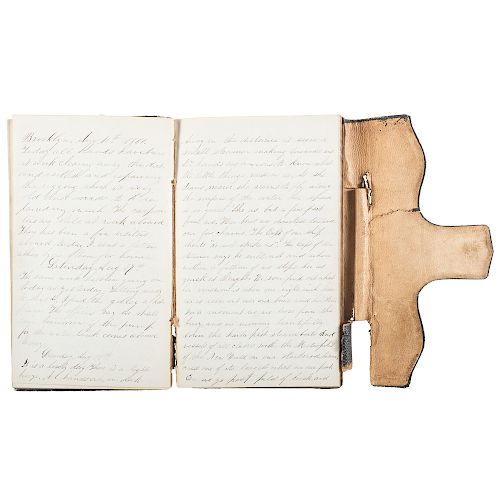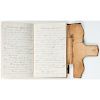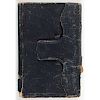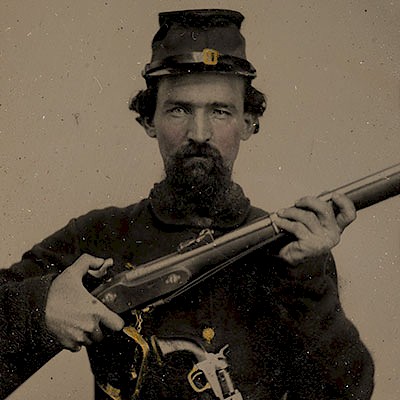Civil War Diary of James Nixon, USN
About Seller
6270 Este Ave.
Cincinnati , OH 45232
United States
With offices in Cincinnati, Cleveland and Denver, Cowan’s holds over 40 auctions each year, with annual sales exceeding $16M. We reach buyers around the globe, and take pride in our reputation for integrity, customer service and great results. A full-service house, Cowan’s Auctions specializes in Am...Read more
Two ways to bid:
- Leave a max absentee bid and the platform will bid on your behalf up to your maximum bid during the live auction.
- Bid live during the auction and your bids will be submitted real-time to the auctioneer.
Bid Increments
| Price | Bid Increment |
|---|---|
| $0 | $25 |
| $500 | $50 |
| $1,000 | $100 |
| $2,000 | $250 |
| $5,000 | $500 |
| $10,000 | $1,000 |
| $20,000 | $2,500 |
| $50,000 | $5,000 |
| $100,000 | $10,000 |
About Auction
Jun 21, 2019
On June 21, Cowan’s Auctions will be offering a remarkable selection of historic photography, letters, documents, flags, political ephemera, and more representing the Revolutionary War-period through the Civil War, Indian Wars, and beyond, as well as the American West. Cowan's Auctions dawnie@cowans.com
- Lot Description
Leather diary contained in a notebook, 4 x 6 in., with flap closure, wallet pocket in rear, identified to James D. Nixon. Entries begin in December 1859, with the first 13pp from the early period. War-date entries begin in July 1861.
James D. Nixon was a 25-year-old currier (leather industry) living in Roxbury, MA when he enlisted in the US Navy on June 12, 1861 at Boston. This was early in the war, and Nixon enlisted for a one-year term as Ordinary Seaman. He served on Receiving Ships Ohio and North Carolina , and USS Supply . He was discharged November 26, 1862 from the North Carolina . He does not appear in some of the Civil War databases, likely because Navy records are spotty. He is listed in Massachusetts Soldiers, Sailors and Marines in the Civil War, compiled and published by the Adjutant General . (Brookline (MA): Riverdale Press printers, 1935: Vol. 8, p. 492.)
His earliest war-date note is as follows:
Wednesday, July 3, 1861
"Days, weeks, months and I might almost say years have passed away since I have written anything in this neglected book."
"Here I am still with those who are travelling the journey of life. By the grace of God I am still living and in health and today am aboard the US Ship of War the Ohio, having enlisted in the Navy the 28th of May for the term of one year."
"I like the service so far, although I have [not?] seen anything but what is to be seen aboard a receiving ship. There are five hundred men aboard. The steamer Susquehanna sailed this morning. Today is visiting day and I expect friends from Chelsea."
July 4: “ …There was a fine salute fired by the sloops Preble and Vincennes and the battery on the dock this noon. There has a large fire broken out in East Boston which is burning shops, stores, dwelling houses and vessels at an alarming extent. The fire has already consumed a no. of acres and is still burning. The largest fire I ever saw and the largest one that has visited this section for many years .”
July 5: “ The fire is still burning. The papers estimate the loss @ from ½ to ¾ of a million dollars .”
July 15: “ This date finds me transferred from the ship Ohio to the ship North Carolina at the Brooklyn Navy yard .”
August 15: “ Was drafted for the store ship Nightingale this forenoon and came aboard in about two hours after. We were all mustered on the poop by the first Lieutenant of the N.C. when the ship was turned over to Capt. D.B. Home of Chelsea Mass by Commodore Foote of the N. Yard. In a few minutes after we hauled out into the stream and anchored abreast of the battery near the N. Caro. At the request of the 3rd officer went into the galley put tings in order built a fire and made tea for all hands fore and aft. The first officer told me to stay in the galley until he got some one to take it. At 9 o’clock set watches and turned in. ”
They spent a few days cleaning and re-rigging the ship to be ready to sail. Once they did sail, Nixon was seasick for several days. About the 22nd of August they made it to Hampton Roads about a mile from Fort Monroe. On the 24th they hoisted anchor and headed for Key West. They were temporarily grounded the next day, but apparently were freed on the tide. The pounding of the ship by waves against the bottom while they were grounded at least convinced many that their ship was a sturdy one.
September 6: “ Arrived in Key West after a pleasant passage. The vessels here are the Harrison and the Wanderer. The weather is extremely hot .”
September 7: “ Went ashore this forenoon…bought some coconuts which were good …The National Guard arrived here from N. York. She sailed four days before us. We have passed every vessel we have seen on our course. Our vessel sails finely .”
September 8 – his seasickness has passed and he feels well again. They are not going to unload at Key West, but rather proceed to Pensacola.
September 9 - Left for Pensacola about a half hour after the Harrison, which had main, main top and main top gallant sails on fore and main masts set. The Nightingale had only two sails set and caught up with and passed the Harrison before dark. They encountered other ships and steamers on the way.
They were becalmed the 11, 12, 13th.
September 14: “… We arrived in P. a few hours behind the M. where the steamer Colorado is stationed. As soon as we dropped anchor our Capt went aboard the C. when he learned that four of the C’s boat crews done one of the most daring deeds ever performed in the Navy. The Commodore, learning that there was a vessel fitted out as a privateer lay at the Navy yard determined to take or destroy her at all hazards. Accordingly he had four boats manned and got ready to make the attack each man armed to the teeth and each boat carrying a howitzer. About two o’clock this morning they started for the yard at three the attack commenced. When approaching the yard they were hailed by the centry [sentry] who receiving no reply fired killing one man. He was instantly killed. No less than a dozen shots were fired at him. The firing alarmed the soldiers in the yard and the men aboard the ship. A part of the men at went into the yard killing many with small arms while the others took possession of the ship killing several and setting the ship on fire. Those that went into the yard were compelled to take to their boats on account of the large numbers that were arriving but not until they had spiked an eleven inch gun and taken the tompkin. Before leaving they fired the howitzer into the crowd killing some thirty. Three were killed in the boats and eleven wounded some badly. The vessel which was a large brig with her contents were totally destroyed. Our Capt says it was one of the boldest things he ever heard of. Some of our boat ‘s crew saw the dead and wounded. ”
September 15 – left for Apalachicola. Arrived September 17. Met up with several steamers, transferring to them an anchor and cable, 3 howsers and 75 tons of coal. Next day sailed 25 miles to SW to load coal on the steamer R.R. Cuyler (Cayler?) (took 2 days). They then coaled another vessel (the Colorado ?), located the Richmond (who needed nothing) and returned to Pensacola. They spent a couple days there making repairs, etc. then headed for Mobile.
September 29: “ Arrived at Mobile this morning. Gave the Mississippi her stores and we are now on our way to the great father of waters .”
September 30: “ Arrived at the mouth of the M. this morning where the Niagara is stationed. Started up the river at eight o’clock this eve for the purpose of obtaining a supply of fresh water. The Preble and the Pampers are here. ”
October 1 – ran aground again. The Richmond , Vincennes and Water Witch were there.
October 3: “ Have been taking out coal to lighten ship. Quite a no. of the N[iagara] crew have been helping us. The steamer South Carolina just came in having two prizes in tow. ”
October 4: “ Have been taking out coal for the N. and Water Witch to day. At half past five the ship floated so we are all right again. We have had four prisoners sent us from the S.C. to take to N. York where we have received orders to go as soon as we get our coal out and the cargoes of the prize schooners aboard. ”
October 5: “ Have been coaling the N. this forenoon this PM have been taking aboard the cargo of one of the prizes, consisting of muskets, carbines, revolvers and swords of English and Spanish manufacture, lead, powder, ammunition, percussion caps, paper, blankets, cigars, coffee &c. ”
October 6: “ …I.C. Kuhn has just hove in sight. The Colorado came up from Pensacola last night and is the custom when two commodores meet fired a salute which was returned by the Niagara. ”
This was his last entry in the notebook. From the beginning, Nixon does not seem to have been a particularly conscientious diarist, which is too bad, since he is literate and has legible handwriting. Navy materials are scarce.Stitching has come loose from first signature, but all pages present. Overall leaves are a bit loose. Some damage to lower spine and closure flap. Very little toning or foxing, which is a bit unusual for items that have been at sea.Condition
- Shipping Info
-
Buyers are required to pay for all packing, shipping and insurance charges. Overseas duty charges are the responsibility of the successful Bidder. Be aware that for larger and/or valuable items, shipping charges can be substantial. - If there is no shipping amount on listed your invoice, you will need to make arrangements to pick up or ship your purchase through an alternative shipping company. Our shipping department can be contacted at 513.871.1670 (ext. 219) or email shipping@cowans.com. - Shipping charges include insurance for your order while in transit. If you have private insurance we will adjust your charge to include only packing and shipping. - Please allow 14 – 21 days after payment to package and ship your purchase as carefully as possible.
-
- Buyer's Premium



 EUR
EUR CAD
CAD AUD
AUD GBP
GBP MXN
MXN HKD
HKD CNY
CNY MYR
MYR SEK
SEK SGD
SGD CHF
CHF THB
THB













